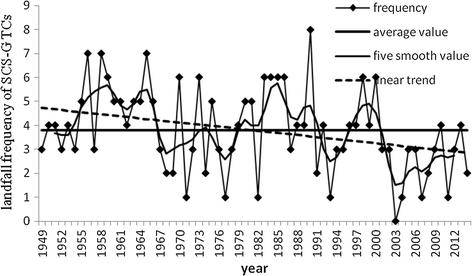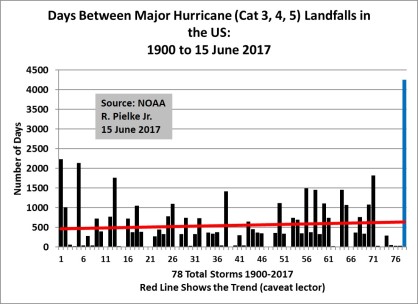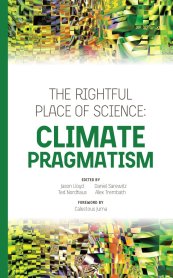 Welcome to issue #3 of my occasional newsletter on climate and energy issues. As a reminder, my day-to-day research or writing is focused on sports governance and various issues of science policy. But I’ve written a fair bit on the topics of climate and energy over the past 25 years, including two recent books and a boatload of academic papers, and I’m paying attention. So caveat lector!
Welcome to issue #3 of my occasional newsletter on climate and energy issues. As a reminder, my day-to-day research or writing is focused on sports governance and various issues of science policy. But I’ve written a fair bit on the topics of climate and energy over the past 25 years, including two recent books and a boatload of academic papers, and I’m paying attention. So caveat lector!
A few things to say up front:
- If you don’t like what I write or don’t like me, then don’t read it – no big deal, I’m just a professor with a blog.
- If you appreciate the perspective, consider the tip jar to your right. And thanks to those of you who have tipped – very much appreciated!
- If you’d like to engage, consider a comment, a Tweet to me (@rogerpielkejr) or an email. I am happy to discuss or debate. I’ve had great feedback on the first 2 issues.
- If you choose to call me names or lie about me, oh-so-common in discussing climate, then you will be blocked or ignored.
With that, some of what I found interesting over the past month . . .
BP Statistical Review of World Energy
Every June, BP publishes one of the world’s best resources on global energy consumption. BP data was at the heart of the analyses I did in The Climate Fix, and are essential for understanding climate and energy policy issues. Here are some analyses based on the just released 2017 data following a methodology described here (in PDF) and here (in much more depth).
- If a goal of climate policy is to stabilize carbon dioxide concentrations in the atmosphere at a low level (e.g., 450 ppm) then emissions have to be reduced to near zero. That means that global carbon-free energy consumption has to be increased to near 100%. This math is as simple as it is relentless. To get a better sense of the effects of climate policy, don’t focus on emissions, instead focus on the proportion of global energy consumption from carbon-free sources — nuclear, hydro and various renewable technologies. Here is that value 1966-2016:

- In 2016, 14.5% of global energy consumption came from carbon-free technologies. That is the highest level since 1966. That is good news.
- However, to put that number into context, the figure below shows what would be needed in the 21st century, if carbon dioxide concentrations are going to be stabilized:

- In round numbers, the world needs a linear rate of increase of ~1% per year, every year, through the end of the century to get above 90% carbon-free energy consumption. By linear increase I simply mean that 14% in 2015 needs to be 15% in 2016, 16% in 2017, 17% in 2018 and so on. If you want to hit that 90% proportion sooner, then the rate of linear increase must be correspondingly higher.
- From 2015 to 2016, carbon-free energy consumption increased from 14% to 14.5%. Notable, but half the needed 1%. That means that the world is actually falling behind. That is the bad news.
- Which countries contributed most and least to the 0.5% increase from 2015 to 2016? Here there are some surprises. I was surprised to learn that China, US and India together were responsible for 100% of the increase in carbon-free energy consumption, while the rest of the world netted out to zero change. Another surprise: The EU actually saw its carbon-free energy supply decrease by a small amount. China is far and away the global leader here.

- What technologies were most responsible for the increase in carbon-free energy from 2015 to 2016? Renewables led the way, but hydro and nukes played a large share as well. For those who envision a world powered only by renewable energy, these numbers are sobering, as renewable deployment is only 1/3 the pace needed.

- Bottom line? The world is decarbonizing its energy systems, slowly. All of the focus on “reducing emissions” tends to obscure what really matters here – the rapid expansion of carbon-free energy consumption. The emphasis on the politics of limits (reducing emissions) rather than the politics of possibility (expanding consumption) deserves some attention as well.
President Trump and the Paris Agreement
As promised during his campaign, President Trump made good on his commitment to declare that the US is leaving the Paris Agreement. It remains unclear what practical significance this has, but it does have considerable symbolic importance – far beyond just climate policy.
Polling data from the Washington Post suggests that Trump’s move played well with his base, and Republicans overall, while strongly opposed by Democrats and Independents:
I have often argued that the intense polarization of the climate issue works very well as a wedge issue in electoral politics (see Ted Nordhaus and Alex Trembath on this issue). At the same time, it is probably fatal to climate policy in the United States. This sets up a difficult dynamic for those actually interested in climate policy – playing the wedge politics game is appealing, and may even confer some short-term electoral benefits. But in the long-run, it all but guarantees that climate policy is going no where fast. Add into that mix the fact that many leading climate scientists are leading the wedge politics charge, and you have a recipe for failure.
Donald Trump and the Republicans could not be more happy with this state of affairs.
Some Science
A few this crossed my screen that are worth sharing:
-
- US drought has decreased over more than a century: “For most of the [continental United States], drought frequency appears to have decreased during the 1901 through 2014 period.”
- Tropical cyclones in the South China Sea making landfall in China and Vietnam declined over 65 years.

- The US National Academy of Sciences just published a review of a forthcoming “Climate Science Special Report.“ Here are some quotes from that review on extreme weather:
- “analysis of global and continental-scale trends indicates that drought severity and other statistics have actually declined”
- “Within the existing literature, few locations show statistically significant changes in flooding nor have they [changes in flooding] been clearly linked to precipitation or temperature”
- “There is some evidence of upward trends in precipitation extremes, but essentially none in floods”
- “flooding is (contrary to popular view) changing in complicated ways with no clear national trend”
- “There is, at best, scant evidence that tornadoes are exhibiting changes linked to climate change”
- Note: NAS says little on hurricanes in the review other than there has been an increase in the NATL since 1970s, consistent with IPCC AR5
- Bottom line: Just like I’ve been telling you
- US hurricane season has started (with no permanent NHC or FEMA directors in place, but I digress). As of today it has been 4,252 days since the last time a Category 3+ hurricane made a US landfall. That is long enough to get lazy and to forget. The streak will not last.

- Cliff Mass at the University of Washington explains what it is like to discuss the science of extreme weather: “Every time I correct misinformation in the media like this, I get savaged by some “environmentalists” and media. I am accused of being a denier, a skeptic, an instrument of the oil companies … My efforts do not go unnoticed at the UW, with my department chairman and leadership in the UW Climate Impacts Group telling me of “concerns” with my complaints about hyped stories on oyster deaths and snowpack. One UW professor told me that although what I was saying was true, I needed to keep quiet because I was helping “the skeptics.” Probably not good for my UW career.”
- Is sea level rise accelerating? No detectable acceleration since 1993 (the altimeter era), but if climate models are accurate, then a signal should be detectable in the next decade.
- Interesting paper comparing energy transitions in Germany and Japan.
Coming Attractions
If you’ve read this far you deserve a preview of a few things to come.
- A new short book is just out in the ASU/CSPO “Rightful Place of Science” series, titled Climate Pragmatism. Could not be more timely:

- Finally, I am giving a public talk in London next month on the politics of the climate debate. My title is “Climate Politics as Manichean Paranoia.” It’ll be a good one. (And funded in part by this blog’s tip jar — thanks!). More details to come.
